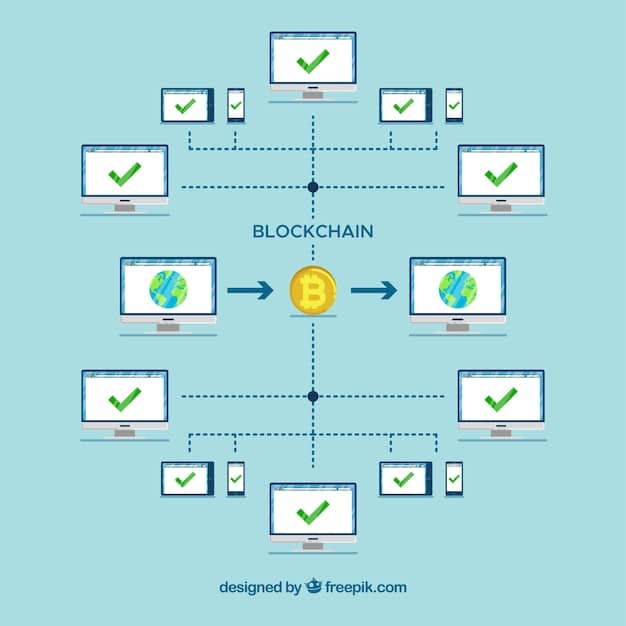Secure Altcoin Storage: Offline Digital Asset Management Guide

Altcoin storage solutions focus on securing digital assets offline to mitigate online hacking risks and ensure the long-term safety of cryptocurrencies.
In the realm of cryptocurrencies, securing your investments is paramount. Altcoin storage solutions: securely managing your digital assets offline, offers a robust method to protect your holdings from online threats, ensuring peace of mind in the volatile crypto market.
Understanding the Need for Secure Altcoin Storage
Altcoins, like all cryptocurrencies, are susceptible to theft and hacking. Secure altcoin storage is crucial to protect digital assets from unauthorized access and potential loss. This section explores the vulnerabilities of online storage and the benefits of offline solutions.
The Risks of Online Wallets
Online wallets, while convenient, are constantly connected to the internet, making them vulnerable to cyberattacks. Exchanges and web wallets are prime targets for hackers, who can exploit vulnerabilities to steal cryptocurrencies. Understanding these risks is the first step in adopting safer storage practices.
The convenience of accessing your altcoins from anywhere comes with inherent risks. Any device connected to the internet can potentially be compromised, leading to the loss of your digital assets. It is essential to weigh the convenience against the security implications.
Benefits of Offline Storage Solutions
Offline storage, also known as cold storage, involves keeping your altcoins in a secure environment that is not connected to the internet. This significantly reduces the risk of hacking and theft. Offline solutions include hardware wallets, paper wallets, and other physical storage methods.
By taking your altcoins offline, you eliminate the potential for remote attacks. This approach provides a higher level of security, particularly for long-term storage. It is a proactive measure to protect your investments from ever-evolving cyber threats.
- Reduced risk of hacking and theft.
- Protection against malware and phishing attacks.
- Greater control over your private keys.
- Enhanced security for long-term investments.
In conclusion, secure altcoin storage is a necessity, not an option, for anyone serious about cryptocurrencies. Offline solutions provide a robust defense against online threats, ensuring the safety and longevity of your digital assets.
Hardware Wallets: A Popular Offline Storage Method
Hardware wallets are dedicated devices designed to securely store your altcoins offline. These devices offer a user-friendly interface and robust security features. This section delves into the advantages, considerations when choosing one, and best practices for using hardware wallets.

Advantages of Using Hardware Wallets
Hardware wallets provide a secure environment for managing your private keys. They are resistant to malware and phishing attacks, keeping your altcoins safe even if your computer is compromised. The physical nature of the device adds an extra layer of security.
The ability to sign transactions offline is a key advantage. Your private keys never leave the device, reducing the risk of exposure. This feature ensures that only you can authorize transactions, providing peace of mind and control over your assets.
Choosing the Right Hardware Wallet
Selecting the right hardware wallet involves considering several factors, including the supported altcoins, security features, ease of use, and price. Researching different brands and models is essential to find the best fit for your needs. Ledger, Trezor, and KeepKey are among the reputable options available.
Ensure that the hardware wallet supports the altcoins you want to store. Look for wallets with strong encryption and secure element chips. A user-friendly interface can also make the process of managing your altcoins more straightforward and less prone to errors.
- Consider supported altcoins.
- Evaluate security features like encryption and secure element chips.
- Assess ease of use and user interface.
- Compare prices and read user reviews.
In conclusion, hardware wallets are a popular and effective offline storage method for altcoins. By understanding their advantages and carefully selecting the right device, you can significantly enhance the security of your digital assets.
Paper Wallets: Creating and Managing Offline Keys
Paper wallets are a simple and free way to store your altcoins offline. They involve generating your private and public keys and printing them on a piece of paper. This section explores the process of creating paper wallets, best practices for securing them, and their limitations.
Generating a Paper Wallet
Creating a paper wallet involves using an offline tool to generate your private and public keys. Several websites and software applications offer this service. It is crucial to ensure that the tool you use is trustworthy and that you disconnect from the internet during the key generation process.
The generated keys are then printed on a piece of paper, which serves as your wallet. This paper should be stored securely, away from prying eyes and potential damage. The process is straightforward but requires careful attention to detail to avoid mistakes.
Securing Your Paper Wallet
Securing a paper wallet involves protecting it from physical damage, theft, and unauthorized access. Store it in a safe, waterproof location. Consider making multiple copies and storing them in different secure locations. Never share your private key with anyone.
Protecting your paper wallet is paramount. Laminate it to prevent water damage, and store it in a fireproof safe to protect against fire. Be cautious about who knows the location of your paper wallet, and consider splitting the paper wallet into multiple pieces to further enhance security.
- Store in a safe, waterproof location.
- Make multiple copies and store them separately.
- Never share your private key.
- Protect from fire and physical damage.
In conclusion, paper wallets are a cost-effective offline storage solution for altcoins. However, they require careful handling and security measures to protect against potential risks. When used with caution, they offer a viable alternative to online wallets.
Multi-Signature Wallets: Enhancing Security with Multiple Keys
Multi-signature wallets require multiple private keys to authorize transactions. This adds an extra layer of security, as no single key holder can access the funds. This section explores how multi-signature wallets work, their advantages, and how to set them up.

How Multi-Signature Wallets Work
Multi-signature wallets work by requiring a certain number of approvals before a transaction can be executed. For example, a 2-of-3 multi-signature wallet requires two out of three private keys to sign a transaction. This prevents unauthorized access and provides added security.
The concept is similar to having multiple signatories on a bank account. No single person can withdraw funds without the approval of the others. This distributed control over your altcoins makes it significantly harder for hackers to compromise your assets.
Advantages of Multi-Signature Wallets
Multi-signature wallets offer enhanced security, reduced risk of theft, and protection against single points of failure. They are ideal for teams, businesses, and individuals who want to ensure the highest level of security for their altcoins. Multi-signature wallets also provide a degree of redundancy.
The added layer of security can deter hackers and increase confidence in the storage of your assets. If one key is compromised, the attacker still needs to obtain additional keys to access the funds. This makes multi-signature wallets an attractive choice for securing large amounts of altcoins.
- Enhanced security against unauthorized access.
- Reduced risk of theft and hacking.
- Protection against single points of failure.
- Ideal for teams, businesses, and individuals.
In conclusion, multi-signature wallets provide a sophisticated approach to securing altcoins. By requiring multiple approvals for transactions, they significantly enhance security and reduce the risk of loss.
Combining Storage Methods for Optimal Security
To achieve the highest level of security, consider combining different storage methods. This approach provides multiple layers of defense against potential threats. This section explores how to mix hardware wallets, paper wallets, and other solutions to create a robust security strategy.
Creating a Layered Security Approach
A layered security approach involves using multiple storage methods in combination. For example, you could use a hardware wallet for your primary storage and a paper wallet as a backup. This ensures that even if one method is compromised, your altcoins remain safe.
This approach creates a multi-layered defense against hacking and theft. It also provides redundancy in case of hardware failure or loss of access to one of your storage methods. Diversifying your storage methods is a prudent way to protect your digital assets.
Implementing a Hybrid Storage Strategy
A hybrid storage strategy involves combining hot (online) and cold (offline) wallets to manage your altcoins. Use a hot wallet for small, frequently used amounts and a cold wallet for larger, long-term holdings. This balances convenience with security.
This approach allows you to quickly access funds for day-to-day transactions while keeping the bulk of your altcoins safely offline. Regularly transfer funds from your hot wallet to your cold wallet to minimize the risk of loss. It is a practical approach for managing your crypto assets effectively.
- Use a hardware wallet for primary storage and a paper wallet as a backup.
- Combine hot and cold wallets for different purposes.
- Regularly transfer funds from hot to cold wallets.
- Diversify your storage methods to create redundancy.
In conclusion, combining storage methods provides a robust and comprehensive security strategy for your altcoins. By implementing a layered approach, you can significantly reduce the risk of theft and ensure the long-term safety of your digital assets.
Best Practices for Offline Altcoin Storage
Adopting best practices is essential to ensure the effectiveness of your offline storage solutions. This section provides actionable tips and guidelines for securely managing your altcoins offline, including key management, regular audits, and disaster recovery plans.
Key Management Strategies
Effective key management is critical to securing your altcoins. Store your private keys in a safe and secure location. Never share your private keys with anyone, and regularly back them up. Consider using a password manager to protect your passwords.
Your private keys are the keys to your kingdom. Treat them with the utmost care and protect them from unauthorized access. Regularly update your passwords and use strong, unique passwords for each account. Store your backup keys in a different physical location than your primary keys.
Regular Security Audits
Conduct regular security audits to identify and address potential vulnerabilities in your storage practices. Review your security measures, update your software, and stay informed about the latest security threats. This proactive approach can help prevent breaches and protect your altcoins.
Regularly assess your security posture and look for areas where you can improve. Stay informed about the latest vulnerabilities and apply security patches promptly. Consider hiring a cybersecurity professional to conduct a thorough audit of your storage practices.
Disaster Recovery Plans
Develop a disaster recovery plan to ensure that you can recover your altcoins in the event of a disaster, such as a fire, flood, or theft. This plan should include detailed instructions for restoring your wallets and accessing your private keys. Store your recovery plan in a secure location.
A well-defined disaster recovery plan can be a lifesaver in times of crisis. Test your recovery plan periodically to ensure that it works as expected. Keep multiple copies of your recovery plan in different secure locations. Share your recovery plan with a trusted family member or friend.
- Store private keys in a secure location.
- Conduct regular security audits.
- Develop a disaster recovery plan.
- Keep software and security measures updated.
In conclusion, following best practices is paramount to the success of your offline altcoin storage strategy. By implementing effective key management, conducting regular audits, and developing disaster recovery plans, you can significantly enhance the security of your digital assets.
| Key Aspect | Brief Description |
|---|---|
| 🔒 Hardware Wallets | Secure devices to store altcoins offline, resistant to malware. |
| 📜 Paper Wallets | Printed keys stored offline; requires careful handling and security. |
| 🤝 Multi-Sig Wallets | Requires multiple keys to authorize transactions, enhancing security. |
| 🛡️ Layered Approach | Combining different storage methods for optimal security and redundancy. |
Frequently Asked Questions
▼
The primary benefit is enhanced security, as offline storage reduces the risk of hacking and unauthorized access by keeping your altcoins away from internet-based threats.
▼
Not all hardware wallets support every altcoin. It’s crucial to check the compatibility of the hardware wallet with the specific altcoins you intend to store.
▼
Use an offline tool to generate your private and public keys, disconnect from the internet during the process, and print the keys on paper for secure storage.
▼
A multi-signature wallet requires multiple approvals to authorize transactions, adding an extra layer of security by preventing single-point-of-failure risks.
▼
Your disaster recovery plan should include detailed instructions for restoring your wallets, accessing your private keys, and securely storing your recovery information in multiple locations.
Conclusion
Securing your altcoins offline is a critical step towards protecting your digital assets from the ever-present threat of cyberattacks. By understanding the risks associated with online storage and implementing robust offline solutions, you can safeguard your investments and enjoy peace of mind in the world of cryptocurrencies.





